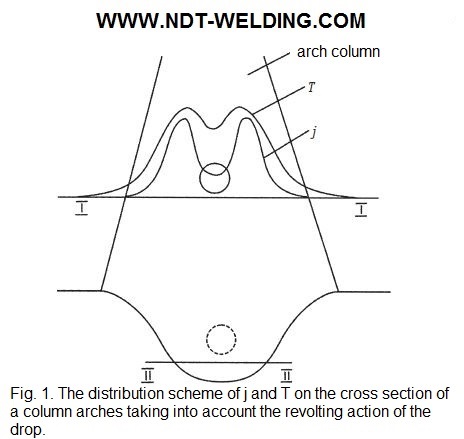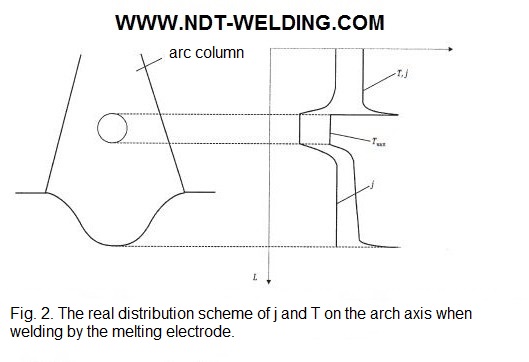Therefore, the drop which is in an arch column because power lines of current can’t sharply change the direction, has to make noticeable change to distribution of density of current in it (see Fig. 1), the section I–I under the drop.
As temperature of the arch column is defined by current density in it, under the drop the arch column temperature has to decrease (see Fig. 1).
 The similar distribution of the current density and temperature has to be observed also in section II-II when the drop approaches a surface of the welding pool. From which it follows that the current density of the arc column and the temperature at the surface of the weld pool are unstable and have a pulsating character, depending on the location of the drop in the column.
The similar distribution of the current density and temperature has to be observed also in section II-II when the drop approaches a surface of the welding pool. From which it follows that the current density of the arc column and the temperature at the surface of the weld pool are unstable and have a pulsating character, depending on the location of the drop in the column.
Given the fact that during deceleration of the gas flow in the arc column at the frontal surface of the gas temperature drop increases, and the current line cannot abruptly change direction, the actual current density distribution and temperature along the axis of the arc given droplet will be of the form shown on Fig. 2.

When present in the arc column at the same time a few drops of the current density and the temperature in the column along its axis will be much less than in the case of the single drop, and the graph will have a wave-like character where the number of ridges and troughs corresponds to the number of drops simultaneously present in the column. Particularly, it should be noted that with the drop in the arc column and the gas flow rate substantially in an arc, which occurs when a jet of metal transfer must be observed the substantial reduction of current density and temperature of the plasma arc axis by drop. Since both of these factors affect the electrical conductivity of the plasma, then according to the above, on the arc column axis when the electrical conductivity of the plasma jet transfers should be considerably lower than in neighboring areas of the column.
This also contributes to the fact that the shock wave is formed in the flow around the plasma flow at the drop of inkjet transfer extends to peripheral region of the arc, located below the drop in cross-section I-I and below (see. Fig. 1). Because the plasma temperature in the shock wave significantly greater plasma temperature in other parts of the arc, then naturally, it also contributes to the electrical conductivity of the plasma in cross section I-I and below (see. Fig. 1). When burning arc with consumable electrode, this phenomenon is not observed.






